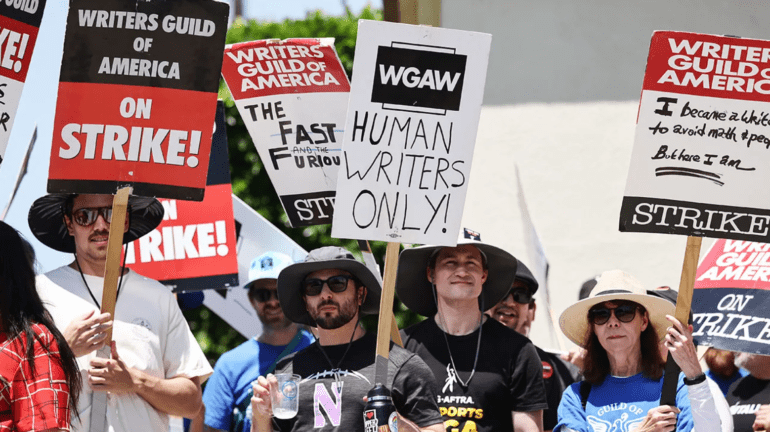TL;DR:
- Hollywood studios propose integrating AI into screenplay creation amid ongoing strikes.
- The Alliance of Motion Picture and Television Producers (AMPTP) presents a vision involving AI tools like ChatGPT for generating storylines and ideas.
- Copyright protection is a key concern for AI-generated scripts; works solely created by AI are not copyrightable.
- Studios aim to leverage human involvement to grant copyright protection to AI-generated content.
- Negotiations focus on compensation and rights for writers working with AI-generated scripts.
- Courts uphold human authorship as crucial for copyright protection, challenging the status of AI-generated content.
- Studios’ maneuvering might reshape the landscape of creative ownership and copyright laws.
Main AI News:
Amid the current standstill in film and television production due to double strikes, a transformative development is gaining prominence within Hollywood’s major studios – the integration of artificial intelligence into the art of screenwriting. The Alliance of Motion Picture and Television Producers (AMPTP), the representative body for studios and streamers, has put forth a noteworthy proposal that could potentially pave the way for AI-generated scripts that are eligible for copyright protection. This move comes in the wake of an intricate dance between industry players, and as the negotiations unfold, a crucial question looms: Can AI-generated content find a secure footing within the realm of intellectual property rights?
In a recent revelation, the AMPTP presented its vision to the Writers Guild of America (WGA), outlining the pivotal role that generative AI tools, exemplified by ChatGPT – an AI bot with the prowess to churn out loglines, pitch ideas, and storylines in mere seconds – could play in the creative landscape. A marked departure from outright prohibition, the AMPTP’s proposal aims to embrace AI technology while ensuring that the creative endeavors of human writers remain valued and unimpeded.
While the proposal addresses several key aspects, a notable omission pertains to the copyright status of works birthed through AI. At its core, this issue stems from the fact that content solely generated by AI lacks the necessary copyright protection. The safeguarding of intellectual property rights necessitates human intervention, as human touch is required to transform AI-created scripts into copyrightable material.
The heart of the matter lies in discerning the balance of power and creative contribution. John Lopez, a member of the WGA’s AI-focused working group, underscores this, asserting that the studios’ perspective has missed the mark. He emphasizes that writers remain an indispensable component in this equation, and the studios need their expertise to breathe life into AI-generated content.
Yet, the studios’ intent is evident – they are eyeing the potential of AI-created scripts while also aiming to capitalize on the intellectual property rights associated with such content. The crux here lies in the human touch; copyright protections come into play when human interaction is interwoven with AI-generated material. This fusion ushers in the potential for novel narratives that bear the mark of both human creativity and AI’s computational prowess.
In the backdrop of negotiations and proposals, the studios’ maneuvering is becoming increasingly apparent. Notable industry figures, including the likes of Disney’s Bob Iger, Netflix’s Ted Sarandos, and Warner Bros. Discovery’s David Zaslav, have engaged in strategic discussions with WGA leadership. The proposal suggests the exclusion of AI-generated content from the category of “literary material,” encompassing stories, adaptations, and screenplays, in the contract. This stipulation, the studios assert, will not compromise writers’ compensation, credit or separate rights.
However, in a swift response, the WGA expressed its dissatisfaction with the proposal, asserting that writers’ interests are inadequately safeguarded. This clash highlights the complexities that arise when attempting to strike a balance between traditional creative processes and innovative AI-driven possibilities.
Amidst this intricate interplay, a pivotal question emerges: Can AI-generated scripts ever attain copyright protection? The landscape is navigable, albeit with a key requirement – human intervention. As the U.S. Copyright Office maintains, AI-generated works are copyrightable only if they bear the imprint of human creativity. This underscores the essence of authorship and creativity, relegating AI to a tool rather than a standalone creator.
Recent legal judgments reflect this stance, with courts upholding the principle that copyright is reserved for human-authored works. As AI-generated content challenges these boundaries, legal interpretations are reshaping the contours of creativity and authorship. A federal judge’s ruling that an AI-created artwork is not eligible for copyright protection reinforces the notion that human authorship remains an essential foundation.
The intricate dance between AI-generated content and copyright protection continues to evolve. The AMPTP’s offer seeks to compensate writers for their engagement with AI-created material, potentially paving the way for AI-generated scripts to gain eligibility for copyright protection. However, writers remain wary, seeing the studios’ maneuvers as a potential attempt to diminish their role in intellectual property rights.
As studios juggle legal battles over iconic franchises and writers exploit copyright recapture provisions, the potential for AI-generated content to extend the lifespan of lucrative properties becomes increasingly significant. Studios’ ownership of AI-created works, coupled with human rewriting, could redefine the dynamics of creative ownership and copyright law.
In the ever-evolving tapestry of copyright law, the path ahead remains uncertain. How much human involvement is required to deem AI-generated content copyrightable? The answer holds significant implications for the future of creativity, technology, and intellectual property rights. The negotiation table remains abuzz with discourse, as stakeholders grapple with the intricate threads that weave AI’s innovation into the fabric of creative expression.
Conclusion:
The collision between AI-generated scripts and copyright complexities underscores the studios’ ambition to harness AI’s potential while securing copyright protection. The negotiations represent a pivotal moment, where traditional creative processes and innovative technology converge. The outcome could redefine the balance of power in intellectual property rights and reshape the future of creative expression in the entertainment industry.

